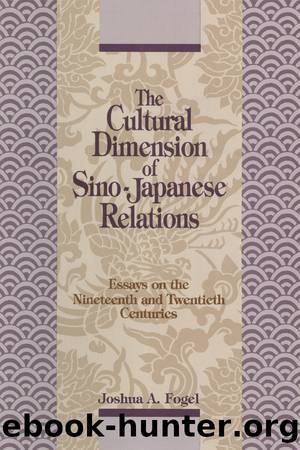The Cultural Dimensions of Sino-Japanese Relations: Essays on the Nineteenth and Twentieth Centuries: Essays on the Nineteenth and Twentieth Centuries by Joshua A. Fogel

Author:Joshua A. Fogel [Fogel, Joshua A.]
Language: eng
Format: epub
Tags: Ethnic Studies, Public Affairs & Administration, Social Science, Political Science, Regional Studies, General
ISBN: 9781317457664
Google: bbq5CAAAQBAJ
Goodreads: 514510
Publisher: Routledge
Published: 1994-12-01T00:00:00+00:00
His account features information on seventy-seven items, from public works projects and agriculture to religious practices, military conditions, opium, women, currency, and poisonous snakes.
Okakura Tenshin (1862â1913) spent the latter half of 1893 in China, and he either ignored or simply missed the harsher side of life in China altogether. Sent by the Imperial Household Department to investigate Chinese art, he concentrated on museums and curio shops and traveled about in Chinese dress with his hair in a queue. From his subsequent speeches and writings mentioning his travels, we can isolate several conclusions he reached. While holding to his favorite slogan that âAsia was one,â Okakura came to believe that there was no one âChinaâ (Shina ni Shina nashi), namely, that the cultures of the Yellow and the Yangzi rivers were sufficiently different to warrant basic distinction.11
As the nineteenth century came to a close, China began increasingly to attract the type of person who fashioned himself rugged. The popular image of China as an age-old country, extremely poor, and much in need of modern conveniences emerged at this time, due largely to the picture of China presented in travel reports. Also, organizations of Japanese adventurers cropped up throughout China beginning in the mid-1890s. When Takase Bintoku arrived in 1902, he insisted on traveling on foot. He noted that Chinese streets were dirty, workers and coolies looked like beggars, and the general populace was filthy and insensate, all images soon to become elemental to any portrait of contemporary China. While a few lived in grand elegance, the lower classes enjoyed a porcine level of hygiene. And here was a severe problem for China: no healthy middle ranks to Chinese society (chūtŠshakai), also a common view over the next few decades. After a lengthy description of life in China, particularly in Beijing, Takase came to the conclusion that China was not a nation (kokka), but 400 million individuals and 4, 000-year-old customs; in the same breath he claimed, apparently unaware of the non sequitur, that the Chinese nation was headed for extinction. He called on foreign (read Japanese) educators, religious leaders, and businessmen to pursue their lines of work in China.12
Among the more famous, and undoubtedly the most obnoxious, travel accounts of the late Meiji period was that of the journalist Tokutomi SohÅ (1863â1957). No sooner had he arrived in Manchuria en route to Beijing than he wrote home to say that merchants in Andong expressed what appeared genuine thankfulness for the protection of their property and persons now available because of Japanese domination in the region. He arrived in the Chinese capital just when âthe rights recovery fever had reached 40° C.â Agreeing with an unnamed English reporter who claimed that the Chinese defiance of the civilized powers derived from this xenophobic fever, he concluded that âârights recoveryâ may be the other side of xenophobia.â And revealing his true colors, Tokutomi added: âWhere will this ⦠movement end? Perhaps it will unite with the anti-foreign movement of the lower classes? Is such an apprehension needless anxiety? I hope it is.
Download
This site does not store any files on its server. We only index and link to content provided by other sites. Please contact the content providers to delete copyright contents if any and email us, we'll remove relevant links or contents immediately.
What's Done in Darkness by Kayla Perrin(26618)
The Fifty Shades Trilogy & Grey by E L James(19096)
Shot Through the Heart: DI Grace Fisher 2 by Isabelle Grey(19079)
Shot Through the Heart by Mercy Celeste(18954)
Wolf & Parchment: New Theory Spice & Wolf, Vol. 10 by Isuna Hasekura and Jyuu Ayakura(17133)
Python GUI Applications using PyQt5 : The hands-on guide to build apps with Python by Verdugo Leire(17023)
Peren F. Statistics for Business and Economics...Essential Formulas 3ed 2025 by Unknown(16897)
Wolf & Parchment: New Theory Spice & Wolf, Vol. 03 by Isuna Hasekura and Jyuu Ayakura & Jyuu Ayakura(16840)
Wolf & Parchment: New Theory Spice & Wolf, Vol. 01 by Isuna Hasekura and Jyuu Ayakura & Jyuu Ayakura(16468)
The Subtle Art of Not Giving a F*ck by Mark Manson(14384)
The 3rd Cycle of the Betrayed Series Collection: Extremely Controversial Historical Thrillers (Betrayed Series Boxed set) by McCray Carolyn(14158)
Stepbrother Stories 2 - 21 Taboo Story Collection (Brother Sister Stepbrother Stepsister Taboo Pseudo Incest Family Virgin Creampie Pregnant Forced Pregnancy Breeding) by Roxi Harding(13674)
Scorched Earth by Nick Kyme(12786)
Drei Generationen auf dem Jakobsweg by Stein Pia(10984)
Suna by Ziefle Pia(10902)
The Ultimate Python Exercise Book: 700 Practical Exercises for Beginners with Quiz Questions by Copy(10437)
D:\Jan\FTP\HOL\Work\Alien Breed - Tower Assault CD32 Alien Breed II - The Horror Continues Manual 1.jpg by PDFCreator(10386)
Scythe by Neal Shusterman(10367)
De Souza H. Master the Age of Artificial Intelligences. The Basic Guide...2024 by Unknown(10356)
